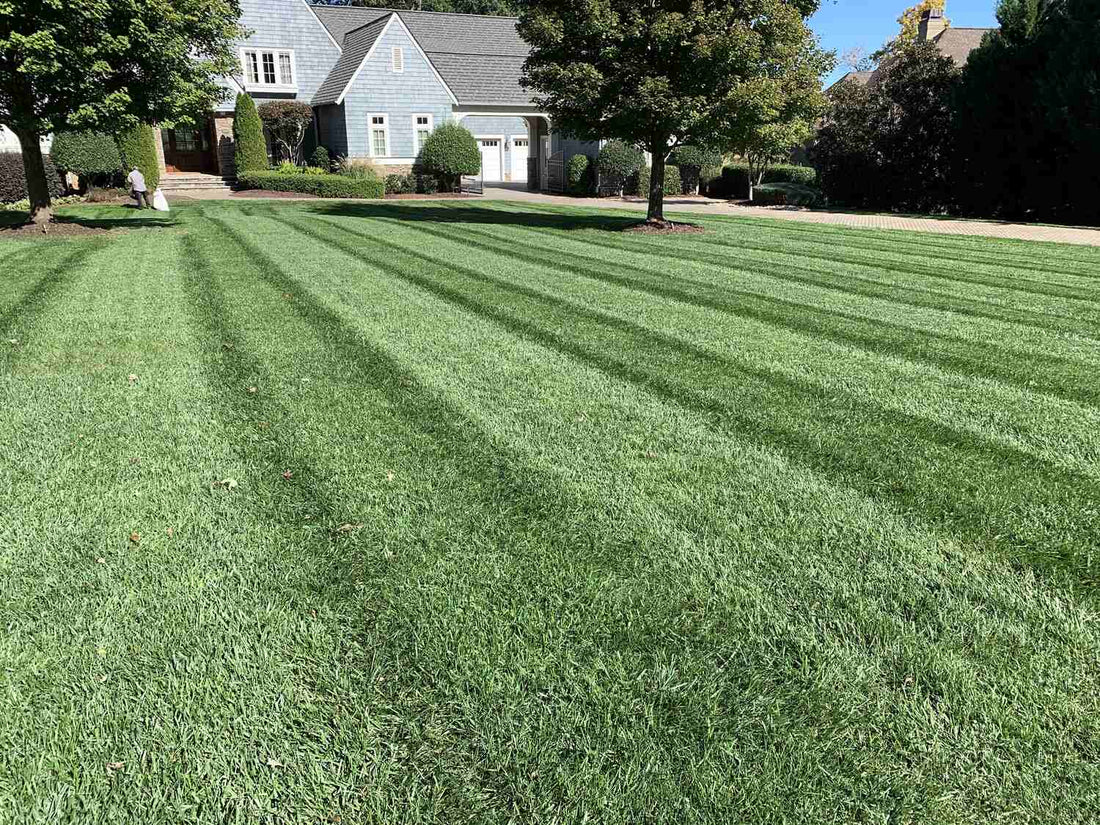At Lawn Synergy, we know that a vibrant lawn is the pride of any home. Fertilizing is key to maintaining that lush, green carpet of grass.
If you're wondering how often to fertilize lawn, you've come to the right place. In this article, we'll answer that question by diving deeper into various topics such as why fertilization is important, the differences between warm-season and cool-season grasses, and much more.
So, if you're ready to transform your lawn and learn the best practices, continue reading. Whether you're a novice or a seasoned gardener, this guide will provide valuable insights to help you achieve the lawn of your dreams.
What this article covers:- Why Fertilization Is Important
- How Often Should Lawn Fertilizer Be Applied?
- Warm-Season vs. Cool-Season
- Set a Lawn Fertilizing Schedule
Why Fertilization Is Important
Fertilization is essential for grass care. It provides the necessary nutrients that may be missing from the soil. From our experience, regular fertilization ensures your lawn remains healthy and strong.
It aids in the germination of grass seed, supports robust root growth, and enhances the lawn's overall resilience. Nutrients such as nitrogen, phosphorus, and potassium play a crucial role in promoting lush, green growth and a sturdy root system.
Proper fertilization also helps your lawn withstand stress from environmental factors like drought, pests, and heavy foot traffic.
At Lawn Synergy, we offer a collection of lawn fertilizers that guarantee excellent results and cater to all your lawn care needs. Among our collection, our standout product is the Emerald 10-0-20 Lawn Fertilizer. Rich in nutrients and suitable for all types of lawns, this specialty fertilizer also contains 10% iron, which is essential for promoting healthy, green growth in your lawn.
Furthermore, this lawn fertilizer is formulated with 45% slow-release technology, ensuring a steady and consistent release of nutrients over time.
This means your lawn receives the nourishment it needs, when it needs it, leading to a vibrant and resilient lawn throughout the year.

How Often Should Lawn Fertilizer Be Applied?
The frequency of fertilization depends on the type of grass and the climate. Generally, lawns should be fertilized every six to eight weeks throughout the growing season.This consistent schedule keeps the nutrients consistently available to the grass.
Warm-season grasses, such as Bermuda and Zoysia typically benefit from more frequent fertilization during their peak growing months in late spring and summer. Almighty 20-0-10 Lawn Fertilizer is the go to for these lawn types because it will supply the nitrogen it needs to thrive.
On the other hand, cool-season grasses like Kentucky bluegrass and fescue thrive with fertilization in early spring and fall. Emerald 10-0-20 Lawn Fertilizer is best for spring and summer on cool season lawns.
From our experience, understanding the specific needs of your lawn's grass type is crucial. For instance, fertilizing too early or too late in the season can result in nutrient waste and potential damage to the grass.
Furthermore, the climate plays a significant role; regions with longer growing seasons may require more frequent applications. Or heavy storms and excessive rain will wash nutrients away leaving the lawn hungry and malnourished.
Regular fertilization is essential to maintaining a lush, green lawn that remains healthy throughout the year.
Warm-Season vs. Cool-Season
Warm-season grasses and cool-season grasses each have unique growth patterns, ideal planting times, and specific care requirements.
Understanding these differences is essential for maintaining a lush, healthy lawn year-round.
By knowing which type of grass suits your region's climate and how to care for it properly, you can ensure your lawn thrives in every season.
Let's look at the differences between warm-season grasses and cool-season grasses:

Warm-Season Grasses
Warm-season grasses, like Bermuda, St. Augustine, and Zoysia, thrive in the heat and should be fertilized in late spring and summer. These grasses are specifically adapted to warm climates and display their peak growth when temperatures are high.
Thesegrasses benefit from monthly fertilization during their peak growing season, which typically runs from late spring through the summer months. Just remember, they need to be watered.
During this period, warm-season grasses are actively growing, and regular fertilization helps provide the nutrients they need to maintain vibrant, healthy growth. Also, by applying fertilizer with iron, it will bring out that darker green color.
Maintaining a consistent fertilization schedule during the growing season is key to achieving a lush, healthy lawn.
Regular fertilization not only promotes vigorous growth but also enhances the lawn's ability to withstand environmental stresses and recover from damage.
Cool-Season Grasses
Cool-season grasses, such as Kentucky bluegrass and fescue, grow best in cooler temperatures. These grasses are particularly well-suited for regions with distinct seasons, flourishing in the cooler temperatures of spring and fall.
They are known for their ability to remain green and active during these times, while they may become semi-dormant during the heat of summer. To maintain their health and vigor, it is crucial to fertilize these types in early spring and fall with more nitrogen. During the summer months, a low nitrogen fertilizer is needed. Emerald 10-0-20 Lawn Fertilizer contains slow-release nitrogen to keep the lawn green and growing.
Applying fertilizer in late fall can help the grass survive the winter by building up nutrient reserves and strengthening root systems. Almighty 20-0-10 will quickly enhance lawns during these months and supply the nutrients they need.
This late fall fertilization, often referred to as "winterizer," supports the grass as it prepares for dormancy, leading to a quicker green-up in the spring.
Consistent fertilization throughout the growing seasons helps cool-season grasses develop a dense, resilient turf that is better able to resist weeds, pests, and diseases. Again, strive to apply fertilizer every 6 weeks for superior nutrition.

Set a Lawn Fertilizing Schedule
Creating a fertilizing schedule is crucial for maintaining a healthy lawn. From our experience, a well-planned schedule ensures your lawn receives the nutrients it needs at the right times.
Here's a seasonal guide to help you maintain a lush, green lawn throughout the year.
Spring
Spring is the start of the growing season. During this time, your lawn is waking up from its winter dormancy and beginning to grow actively.
Apply a pre-emergent fertilizer to give your lawn a nutrient boost and protect the lawn from weed seed germination. This helps also strengthen and prepares the lawn for the upcoming warm months.
This initial feeding lays the groundwork for a healthy lawn by promoting strong root development and vigorous growth.
Summer
In summer, warm-season grasses are in full swing. Apply fertilizer every six weeks to maintain their growth and color.
However, be cautious not to over-fertilize, as this can stress the grass, especially during periods of extreme heat. Make sure each application does not exceed 1 lb of nitrogen per 1,000 sq. ft.
For cool-season grasses, continue to apply fertilizer every six weeks but use a lower nitrogen fertilizer that contains at least 45% slow-release nitrogen, 15-20% potassium, and iron for dark greening.
Providing the right amount of nutrients helps your lawn cope with the heat and stay healthy throughout the season.
Fall
Fall is an important time for cool-season grasses. Apply fertilizer in early fall to support root growth, which is crucial for winter survival. Apply starter fertilizer if you be installing grass seed or aerating and overseeding. Starter fertilizer will quickly enhance the seed germination while providing necessary nutrients they need to grow. Almighty 20-0-10 Fertilizer can be used instead without seeding.
A late fall application can also be beneficial, ensuring the grass remains healthy through winter. From September until cool-season lawns begin dormancy, 20-0-10 Lawn Fertilizer can be applied every six weeks for maximum nutrition. Lawns following this schedule will be screaming green!
This additional feeding helps cool-season grasses store energy and nutrients, leading to a quicker green-up in the spring.

Winter
Winter requires minimal fertilization. Since grass growth slows significantly or stops, a light application of fertilizer can help maintain nutrient levels without promoting excessive growth.
Avoid heavy fertilization as the grass is dormant, and excess nutrients may be wasted or cause damage.
A small amount of fertilizer in winter can support the lawn's health and prepare it for the spring growing season. Right before lawns go dormant is the best time to apply a winterizer fertilizer.
IMAGE 5. Alt tag: “how often can I fertilize my lawn”
Conclusion
A thriving, vibrant lawn is within reach when you know how often to fertilize your lawn and follow a well-planned schedule.
From our experience, fertilizing your lawn at the right times throughout the year is crucial to its health and resilience.
Whether it's cool-season grasses that need attention in early spring and fall or warm-season grasses that benefit from monthly feeding in the summer, understanding your lawn's specific needs makes all the difference and it should be consistant.
For more personalized advice and top-quality lawn care products, visit Lawn Synergy. Our landscaper-grade fertilizers and expert tips will transform your outdoor space into the envy of the neighborhood.
Start your journey to a greener, healthier lawn with Lawn Synergy today!
If you want to learn more, why not check out these articles below:
- How Long Does Lawn Fertilizer Take to Work
- Will Fertilizer Kill New Grass
- Weed and Feed or Grass Seed First
- How Much Fertilizer for Lawn
- How Does Grass Grow
- Best Organic Fertilizer for Lawn
- Best Weed and Feed for Lawns
- Best Lawn Fertilizer for Texas
- Best Lawn Fertilizer for Florida
- Best Time to Fertilize Before or After Rain
- Best Lawn Fertilizer for Winter
- Best Time to Fertilize Lawn Before or After Mowing
- Liquid vs Granular Lawn Fertilizer
- Can You Put Starter Fertilizer on Existing Grass
- Lawn Food vs Fertilizer

